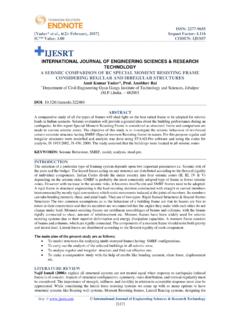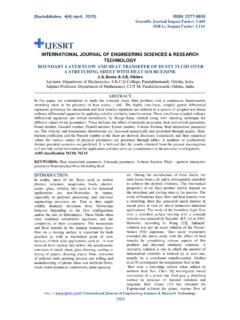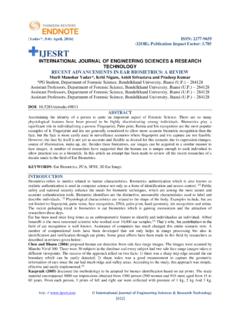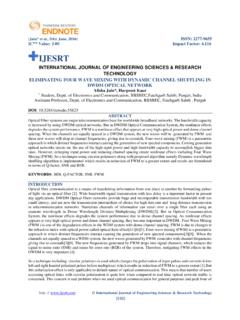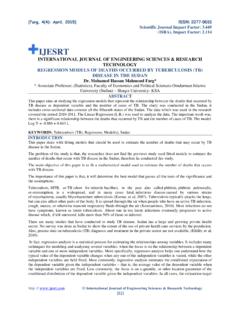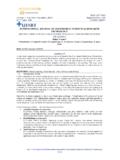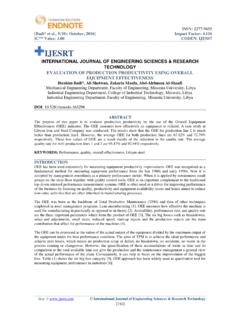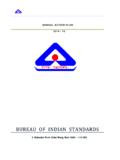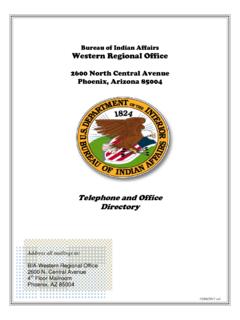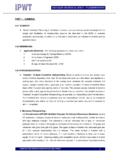Transcription of ISSN: 2277-9655 et al., IC™ Value: 3.00 CODEN: …
1 ISSN: 2277-9655 [Batle* et al., 6(2): February, 2017] Impact Factor: IC Value: CODEN: IJESS7 http: // International Journal of Engineering Sciences & Research Technology [728] IJESRT INTERNATIONAL JOURNAL OF ENGINEERING SCIENCES & RESEARCH TECHNOLOGY FERROCRETE CONCRETE Balte Sanjay*1 , *1PG Student, Department of Civil Engineering, , Ahmednagar, India 2 Assistant Professor, Department of Civil Engineering, , Ahemdnagar, India ABSTRACT Concrete is a versatile material for civil engineering construction. It has many advantageous properties such as good compressive strength, durability, specific gravity and fire resistance. It has some bitter properties, like- low tensile strength, brittleness, lower impact strength, heavy weight, etc.
2 Still concrete is better option than any other available materials for civil engineering constructions. Some of the properties can be enhance by adding fibers with another ingredients of the concrete. The fibers inclusion in concrete acts as unwanted micro crack arrester. In presence of fibers the crack prorogation is delayed which helps in improvement in static and dynamic properties of concrete. KEYWORDS: concrete, compressive strength INTRODUCTION Fibres are usually used in concrete to control plastic shrinkage cracking and drying shrinkage cracking. They also reduce the permeability of concrete and thus reduce bleeding of water. Some types of fibres produce greater impact, abrasion and shatter resistance in concrete.
3 Generally fibres do not increase the flexural strength of concrete, so it cannot replace moment resisting or structural steel reinforcement. Some fibres reduce the strength of amount of fibres added to a concrete mix is measured as a percentage of the total volume of the composite (concrete and fibres) termed volume fraction (Vf). Vf typically ranges from to 3%. Aspect ratio (l/d) is calculated by dividing fibre length (l) by its diameter (d). Fibres with a non-circular cross section use an equivalent diameter for the calculation of aspect ratio. If the modulus of elasticity of the fibre is higher than the matrix (concrete or mortar binder), they help to carry the load by increasing the tensile strength of the material. Increase in the aspect ratio of the fibre usually segments the flexural strength and toughness of the matrix.
4 However, fibres which are too long tend to ball in the mix and create workability recent research indicated that using fibres in concrete has limited effect on the impact resistance of concrete materials. This finding is very important since traditionally people think the ductility increases when concrete reinforced with fibres. The results also pointed out that the micro fibres is better in impact resistance compared with the longer fibres. NECESSITY It increases the tensile strength of the concrete. It reduce the air voids and water voids the inherent porosity of gel. It increases the durability of the concrete. Fibres such as graphite and glass have excellent resistance to creep, while the same is not true for most resins.
5 Therefore, the orientation and volume of fibres have a significant influence on the creep performance of rebars/tendons. MATERIALS AND METHODS Steel Fiber A no of steel fiber types are available as reinforcement. Round steel fiber the commonly used type are produced by cutting round wire in to short length. The typical diameter lies in the range of to Steel fibers having a rectangular c/s are produced by silting the sheets about thick. Fiber made from mild steel drawn wire. Conforming to IS:280-1976 with the diameter of wire varying from to have been ISSN: 2277-9655 [Batle* et al., 6(2): February, 2017] Impact Factor: IC Value: CODEN: IJESS7 http: // International Journal of Engineering Sciences & Research Technology [729] practically used in India.
6 Round steel fibers are produced by cutting or chopping the wire, flat sheet fibers having a typical c/s ranging from to in thickness and to in width are produced by silting flat sheets. Deformed fiber, which are loosely bounded with water-soluble glue in the form of a bundle are also available. Since individual fibers tend to cluster together, their Steel fiber uniform distribution in the matrix is often difficult. This may be avoided by adding fibers bundles, which separate during the mixing process. Polypropylene Fiber Polypropylene Fiber Polypropylene is one of the cheapest & abundantly available polymers polypropylene fibers are resistant to most chemical & it would be cementations matrix which would deteriorate first under aggressive chemical attack.
7 Its melting point is high (about 165 degrees centigrade). So that a working temp. As (100 degree centigrade) may be sustained for short periods without detriment to fiber fibers being hydrophobic can be easily mixed as they do not need lengthy contact during mixing and only need to be evenly distressed in the short fibers in small volume fractions between to 15 commercially used in concrete. Cement The cement used in this experimental work is Ulttratech 53 grade Ordinary Portland Cement . All properties of cement are tested by referring IS 12269 - 1987 Specification for 53 Grade Ordinary Portland Cement. Fine Aggregate River sand confirming to IS 383-1970 is used. Various tests such as specific gravity, water absorption, sieve analysis etc.
8 Have been conducted on to know their quality & grading. ISSN: 2277-9655 [Batle* et al., 6(2): February, 2017] Impact Factor: IC Value: CODEN: IJESS7 http: // International Journal of Engineering Sciences & Research Technology [730] Coarse Aggregate About 20 mm size of coarse aggregate is used for concrete preparation. tests such as specific gravity, water absorption, impact strength, crushing strength, been conducted on to know their quality. Water In ferrocrete, the water used for mixing cement mortar should be fresh, clean and fit for construction purposes; the water of pH equal or greater than 7 and free from organic matter such as silt, oil, sugar, chloride and acidic material PREPARATION OF MIX The grade of concrete used in the present study is M25.
9 The mix design of the concrete is carried as per the specific code IS 10262 2009. EXPERIMENTAL WORK Destructive test conducted on Concrete In present study cube compression test, flexural test on beams and Cylindrical split tensile test on self-compacting concrete with constant fraction of steel fiber were carried out. Compressive Strength Test A cube compression test is performed on standard cubes of of size 150 x 150 x 150 mm after 3, 7 and 28 days of immersion in water for curing. The compressive strength of specimen is calculated by the following formula: fcu = Pc /A Where Pc = Failure load in compression, KN A = Loaded area of cube, mm2 Split Tensile Test The split tensile test is well known indirect test used to determine the tensile strength of concrete.
10 Due to difficulties involved in conducting the direct tension test, a number of indirect methods have been developed to determine the tensile strength of concrete. 150mm dia. concrete cylinder Fig3 Cylinder split tensile test setup The tensile strength at which failure occurs is the tensile strength of concrete. In this investigation, the test is carried out on cylinder by splitting along its middle plane parallel to the edges by applying the compressive load to opposite edges. The arrangement for the test is shown in photo with the pattern of failure. The split tensile strength of cylinder is calculated by the following formula, ft = 2P / LD Where, ft = Tensile strength, MPa ISSN: 2277-9655 [Batle* et al., 6(2): February, 2017] Impact Factor: IC Value: CODEN: IJESS7 http: // International Journal of Engineering Sciences & Research Technology [731] P = Load at failure, N L = Length of cylinder, mm D = Diameter of cylinder, mm ACKNOWLEDGEMENTS We sincerely express our deep sense of gratitude towards my respected guide Prof.

